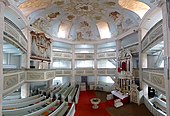St. Cyriaki and Nicolai (Schwenda)
The Protestant Church of St. Cyriaci and Nicolai is in Schwenda , a district of the Südharz community in the Mansfeld-Südharz district in Saxony-Anhalt . It belongs to the parish area Stolberg in the parish of Eisleben-Sömmerda of the Evangelical Church in Central Germany .
history
The main attraction of Schwenda, affectionately called the little sister of the Frauenkirche by the residents , is the Baroque church of St. Cyriaki and Nicolai, which was built from 1736 to 1738 according to plans by the Count of Stolberg's Chamber and Mountain Councilor Johann Friedrich Penther, who had already moved to Göttingen at that time .
Before the Reformation
Schwenda was a parish church village within the county of Hohnstein until 1305 and was then given to the Ilfeld monastery until the place came to the Counts of Stolberg at the end of the 15th century. The name saints Cyriacus and Nikolaus indicate a great age.
Founding legend
In the 16th century, so-called Venedians often came to the Harz as ore and mineral seekers to explore deposits. Today it is assumed that these Venedians were looking for glass decolorizers and glass colors for glass production in Murano .
According to legend, the church owes its existence to the foundation of an Italian nobleman named Mathilde Brilliperi from Venice . In 1578, accompanied by her parents, she is said to have come through the Harz Mountains on the Eselstreiberweg near Schwenda when the tour company got caught in a thunderstorm.
All but one-year-old Mathilde were killed by lightning. The signet rings of the dead were marked Brilliperi. Mathilde was brought to the pastor of Schwenda, who took her in and raised her. Twelve years later, in 1590, two cousins traveled through the Harz Mountains again in search of the family and found Mathilde with Pastor Schaubius von Schwenda, who presented the signet rings as proof. Mathilde traveled back to Italy. Another 63 years later, the grandsons of Countess Mathilde arrived in Schwenda with a considerable sum. Mathilde had decreed that a round church like St. Peter's Basilica in Rome should be built at the place of her rescue . The only condition was that the entrance should face south.
Church building
Like the Dresden Frauenkirche, the church stands on eight supporting pillars. The eight sandstone pillars support a wooden monastery vault. Including the two surrounding galleries, the church offers seating for a total of 300 people. The external height is 34 m, the internal diameter 15 m.
Furnishing

The domed vault with the ceiling painting by Karl Völker (Halle / S.) From 1938 shows the eye of God surrounded by the four evangelists , the four archangels and the four seasons (shown as bouquets). In between are the signs of the zodiac. The wooden baroque pulpit altar was made in 1695 by the Stolberg master Wilhelm Michaelis.
The romantic organ with 18 registers , two manuals and a pedal was made by Julius Strobel from Frankenhausen in 1864 with prospect pipes from an old predecessor organ by the Nordhausen master Heinrich Depée. It was restored in 2005 by the Bernburg organ building company Kapischke & Friedrich.
Web links
- Information about the church on the website of the church district
Individual evidence
- ↑ Excursion destinations in the Harz Mountains , accessed on January 2, 2018
- ↑ Mitteldeutsche Zeitung , accessed on January 2, 2018
- ↑ Portrait on YouTube , accessed on January 2, 2018
- ↑ Uwe Pape (Ed.): Lexikon Norddeutscher Orgelbauer, Volume 1: Thüringen und Umgehung, pp. 51, 195 and 292. Pape Verlag, Berlin 2009, ISBN 978-3-921140-86-4
- ^ Organ restoration , accessed on January 2, 2018
Coordinates: 51 ° 33 '34.3 " N , 11 ° 1' 15.4" E



